By Paul Eastwood BSc Chek Kinesis – Trainer to the stars and metabolic type nutritionist
Cellulite is one of the ‘dirty’ words in the health, fitness or beauty industries; no body wants it, no body talks about it and those that do suffer with it are infuriated that not everyone has the same problem.
Why does it appear on some women more than others and why do some men actually get it? This is a fairly recent phenomenon that initially seems to identify with random women and in rarer cases certain men too1.
Nobody likes to talk about it, because no body really knows what it is and how it is formed, this is due to the research being pretty vague until very recently on what cellulite actually is; never mind what causes it and it’s finally becoming clear on how to treat it.
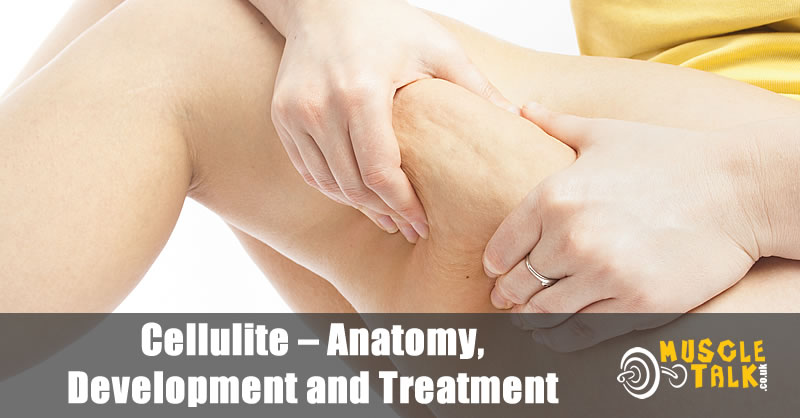
Contents
Cellulite History
The first reference to cellulite was not until 1978 by Scherwitz & Braun-Falco2, their examination of cadavers contained some now known errors on the anatomy of cellulite, but given the lack of peer research at the time, they didn’t have a lot to go on; however they did start the research process.
An artist’s impression is seen in diagram 1, which contains inaccuracies in its anatomical model which I will explain. The bunching of adipose cells towards the surface is correct in diagram 1, except it isn’t septae that pulls the skin down, rather more of a column of adipose cells that pushes up3. Thus disregard the septae strands and be more aware of certain columns of fat cells becoming loose and free and bulging upward to softer tissues.
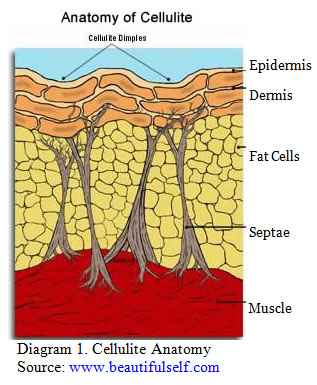
Diagram 1 is very typical of current thinking as previous research has been skewed with errors and has offered no good advice to the trainer, fitness professional or practitioner. In regards to errors in research, take Scherwitz & Braun-Falco, their early cadaver studies concluded that skin dimpling was characteristic of women, not cellulite2.
They also concluded men did not get cellulite as the subcutaneous layer of skin is thinner and has a crisscrossing pattern of septae that divide the fat chamber into smaller polygonal units2. One good piece of information they mentioned was that they found the pinch test is only positive in androgen deficient men. This is a good indicator about what triggers cellulite (hormones) although this was completely overlooked by them and other researchers, until recently.
In 1986, Markman & Barton corrected many of the errors mentioned from Scherwitz & Braun-Falco above and took a step nearer the truth by concluding; cellulite occurs when the deeper layer of the dermis breaks down and the fat is allowed to bulge towards the superficial layer of the skin4, causing a dimpling effect.
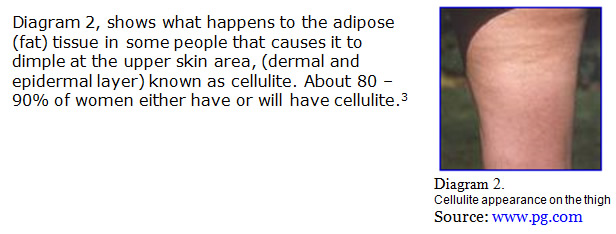
A little more truth was uncovered in 1991, by Lockwood5 when his cadaver and body-contour analysis defined two types of cellulite. These were primary and secondary cellulite. Primary cellulite was characterized by larger or hypertrophied superficial fat cells. Secondary cellulite was a result of sloppiness in the skin probably caused by sun damage; aging or severe weight loss5.
Similar to Markman and Barton, Lockwood believed the skin layers themselves lost adhesive and failed to keep fat cells from protruding into the dermis. Lockwood concluded that it was more the superficial layer of the skin that broke down, allowing fat to protrude up and cause the undulations that characterise cellulite, rather than the deeper dermal layer as concluded by Markman & Barton.
These two theories are very close to the truth as it is very specific parts of the dermis that do break down and cellulite dimpling is also caused by the fat cells undergoing hypertrophy3. Lockwood’s model was the best interpretation available, until very recently, however, newer research offers a fresh look at cellulite.
The latest Cellulite Research
Cellulite, sometimes called gynoid lipodystrophy is believed to result when subcutaneous adipose tissue protrudes into the lower reticular dermis, thereby creating irregularities at the surface1. The irregular, orange peel type dimpled skin surface is characteristic of cellulite and is reported to appear in the thighs, abdomen, and buttocks in 85% of post-adolescent women4. Cellulite is unrelated to the condition, cellulitis, which is infection of the skin and its underlying connective tissue.
Only two researchers have recently have detected the true main culprit for cellulite production – Peter Pugliese & GE Pierard. Cellulite is an interaction of the adipose tissue and connective tissues upon which the sex hormones act3. Pugliese goes on to say that fat can be considered a sex organ, just as the skin is considered one. This means the hips and thighs are the most common areas of cellulite production due to how this fat is utilized.
Fat on any part of the body is governed by metabolic or hormonal needs, the latter determines if cellulite appears. The hips and thighs are area’s more under the control of hormones in women as they are reserved for pregnancy and lactation6, this is why these are the most common sites for cellulite in women and in rarer cases men3.
In fact, cellulite is a natural process in females induced by the hormone oestrogen 3,6,7; this hormone’s major function is to breakdown the collagen in the cervix at the time of delivery to allow the passage of the baby.
Oestrogen begins this function at puberty and continues to well after menopause3. This fits in well with Scherwitz & Braun-Falco research as they found the presence of cellulite in an 8-year old child, progressing in severity to a 79-year old great-grandmother2. It is now known, that women suffer with cellulite due to oestrogen, men have little cellulite because they have little oestrogen3.
It is interesting to note that collagen breakdown is a biological function of cellulite and this would logically mean that women with excess cellulite are suffering from excess collagen breakdown.
The following diagram demonstrates the complete cellulite process:
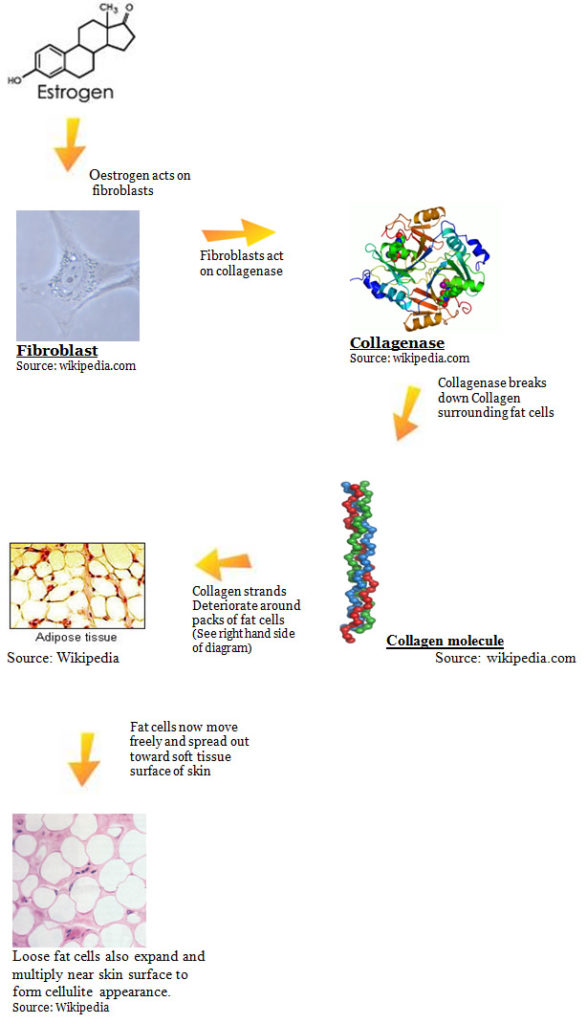
There are five very important learning outcomes from this flow chart diagram and this discussion thus far:
- Oestrogen stimulates the fibroblasts to make collagenase which acts on collagen and breaks it down, which starts the cycle of cellulite formation
- Collagen is lost in the formation of cellulite
- Without collagen fibres, fat cells escape out of tightly packed groups and move toward the skin surface and enlarge to their full size (hypertrophy)
- When fat cells reach their full size, they stimulate preadipocytes to develop to form new adipocytes or fat cells
- Oestrogen naturally acts on or stimulates the preadipocytes to form new adipocytes and the more fat you have, the more the ovaries are stimulated to produce oestrogen3
What is now created is a very vicious cycle which begins again, every time the formation of new fat cells or adipocytes is activated, these new fat cells induce greater oestrogen levels into the body therefore stimulating the whole process to begin again; this is why cellulite formation can and does get out of control.
So why then are certain women more affected by cellulite and this vicious cycle? It must be that some women control and regulate their oestrogen levels more so than other female counterparts. Lower oestrogen levels leads to lower fibroblast activation and a lower or absent cycle of above events.
There are reports of some women being completely free from cellulite altogether, for instance Asian and eastern parts of the world display women with little to no cellulite8.
It’s not surprising cellulite is such a nasty word in the industry, we all know it looks distasteful, but now we also know that if you have cellulite, you’re fat cells have broken free, started to enlarge and then multiply.
On top of this you have to add that you’re hormonally imbalanced and you’re collagen levels are low and unless you do something, you’re body is telling you, it’s only going to get worse! In the second part of this article, we look at how to treat cellulite and discuss what research methods have been used that don’t work, as well as show you which dietary regimes and exercise types can more effectively treat cellulite.
Cellulite Treatments (How to Get Rid of Cellulite)
In the second part of this article, we look at how to treat cellulite and discuss the various research methods that have been published. I will be honest with you, some, if not most, that have been used don’t work, but some very recent studies have shown more promise in treating cellulite. Let’s look first at what research methods have been used and determine their success.
There are a whole host of studies ranging from topical creams9, massage10, Xanthines9,11, Botanicals12, diet and exercise13 and heat treatment14 and, as is always the case, when you have this many different types of studies to treat the same condition, then this is a big giveaway that there is a lack of understanding on how cellulite develops.
All these studies have had limited success in their various area’s of expertise due to people’s individual cellulite severity and actual method efficacy. The researchers treating cellulite as a skin condition have had a reasonable success rate on subjects, but they’re treatments are only temporary at best and would require many repeated visits making time and cost a big issue.
More surprisingly the research using diet and exercise was not much more successful than those using the aforementioned alternative treatments; in fact some people’s cellulite worsened with weight loss13.
Another set of studies have also looked at trying to identify why certain people are more prone to cellulite and thus predict who is most likely to suffer with it, but these studies showed no real success either15.
In the quoted study for example15, the researchers concluded that cellulite severity was concluded by the percentage of body fat the individual had as well as the area of the dermal-subcutaneous border.
Well, we all know the more fat you have the more likely you will have cellulite produced somewhere, and as for the dermal border, no one without fine scientific instruments can use that information to help themselves against cellulite occurring.
To cap it all off, in a recent review of cellulite and its treatment, AV Rawlings in the UK concluded that, “both oral and topical routes may be the best intervention to ameliorate the signs and symptoms of cellulite9.” Oral and topical treatment! This really is another way of saying – we just don’t know what works best yet!
This is because cellulite production is a complex issue involving many different stages and unless you really know and appreciate the cycle of events that I described to you in my last article; trying to intervene at the wrong stage of this vicious cycle won’t have a profound effect at all.
Treatment methods
Cellulite treatments are as confusing and varied as the published causes for cellulite, with many therapies billed in the market place as helping to reduce cellulite, but are temporary with continued visits at best:
Packs and wraps
The basis of these methods is a mechanical action used to ‘break up’ or ‘burn up’ fat or cellulite. In all honesty, they do neither; these treatments move a small amount of interstitial water around only11. This would fulfil a psychological benefit only for the client as there is no physiology changed.
Wraps
Wraps that do combine the use of certain herbs have some positive effect. This is due to the skin being semi-permeable and thus able to pull certain nutrients down into the dermis this way, see diagram 4 for dermal layer depth. Herbs of noted value are – gotu kola, Paraguay tea, coleus forskolii and fennel11.
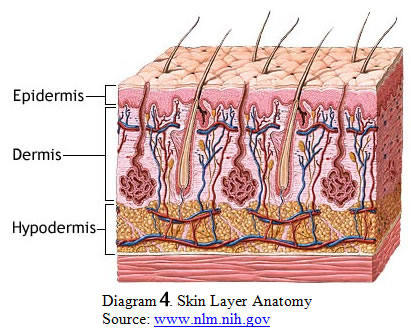
Suction, rolling and pressure devices
This is probably the most dangerous of all cellulite treatments as these mechanical devices can actually make the condition worse by inflicting damage on an already weakened support structure within the skin19. Fortunately many websites that report on cellulite treatment now know this, even though I doubt the typical person would think to visit there first before a treatment.
Topical herbal treatments
This concept is similar to wraps, for these herbal treatments to be effective they must be formulated properly so that the active ingredients reach the fatty layer or at least penetrate down to the superficial layer. There is a certain technique involved here, as if not formed properly, the water soluble ingredients will not penetrate the skin easily and work at all.
Typical ingredients you find here are caffeine, theophylline and coleus forscholii19. A newer study quoted yohimbe, aminophylline and isopreterol8 as they can actually stimulate lipolysis. This is mainly due to the action of epinephrine or adrenalin acting on adipocytes to release fat into the blood stream from within a cell25.
Circulation enhancers and lymphatic drainage
Cellulite severity is increased by interstitial fluid retention or congestion as its better known19,26, lymph flow is also slowed with cellulite and as the lymphatic vessels have no muscles to pump the fluid with, therefore a build up occurs aggravating the fatty mass and thus the cellulite appearance11,19.
Capillary blood flow is also slowed, which accounts for most of the reduced lymph flow, as the former affects the latter3, any fluid here depends purely on tissue movement to work. Due to this, lymphatic drainage offers a positive effect for the interstitial congestion caused by cellulite.
A word of caution, it does not treat cellulite, rather it treats the conditions such as sluggish circulation and increased capillary pressure3.
Xanthines and xanthine derivatives
Xanthines are a group of compounds that naturally occur in the body and while they are by-products of tissue breakdown, they have many functions in the body3,8. One of xanthines main roles is to inhibit an enzyme called phosphodiesterase or PDE.
When xanthines inhibit PDE activity, cyclic AMP (cAMP) can work for a longer duration thereby increasing lipolysis in that area3. Xanthines are also best used away from meal times as insulin is so powerful at reducing lipolysis and shutting off fat breakdown and producing an anabolic effect; it is imperative for any lipolytic to work that insulin be inactive3. Clearly, best times for treatments will be early morning or very late, near bed time.
Collagenase-blocking agents
This is a much better treatment as it interferes with the vicious cycle of cellulite formation that I explained in part 1 of this article. By blocking collagenase the adipocytes held in tight packs with collagen are maintained, this prevents the fat cells (adipocytes) from escaping and enlarging to their full size and stimulating more fat cell production.
This is one of the underlying issues of cellulite – weakened connective tissue, with collagen constantly being broken down the tissues here are so structurally ‘soft’ or weak. This is quite serious, as any heavy or abrasive movement from mats or objects or even hands or other people knocking into you can increase tissue damage and aggravate cellulite appearance.
The best way to block the effect of collagenase (and elastase) is by the use of bioflavenoids, most notably proanthocyanidins3. These compounds are very expensive but when mixed correctly, about 1-1.5% of proanthocyanidins is necessary to provide an effective blocking agent, only then can you prevent further breakdown of collagen3.
Liposuction, Vitamin A and C
Liposuction as said in vacuum suction is not to be used and can actually make cellulite worse by causing damage to already weak skin structures. For every adipocyte lost in liposuction, you can bet that the damaged weak skin structure that goes with it will only allow many times more adipocytes to be released afterwards.
Vitamin A and retinoic acid have a small effect on cellulite, but they don’t cure it3, vitamin C is also helpful, as is citric acid, due to their ability to restore collagen, but they don’t stop the destruction of it!11
Phytoestrogens
By far the most exciting dietary research and information involves the use of phytoestrogens, albeit at slight indirect references. Almost all the research I will quote determines how effective phytoestrogens are at controlling oestrogen levels.
Oestrogen as we now know is responsible for a complete cycle of events as it plays the most dominant role in cellulite development. I say this as oestrogen stimulates fibroblasts to act on collagenase which breaks down collagen, allowing fat cells to float up to the skin surface and as fat cells break free of collagen strands, they enlarge and stimulate new fat cells to be made.
When new fat cells are made more oestrogen is produced so it can mature these new fat cells from preadipocytes to adipocytes11, and with more oestrogen made, more fibroblasts are stimulated and – the whole process starts again.
Thus it stands to reason, if you can control oestrogen levels, then you can control cellulite production. To further support this hypothesis, it has been noted that Asian populations who consume the most phytoestrogens20, have the least amount of cellulite in their population21.
As a result of this and their high consumptions of phytoestrogens (50 – 300 milligrams) they have become the focus of many studies to determine the impact of phytoestrogens on health. Asians consuming 100g of soybean a day were getting isoflavone protection in the form of daidzein and genistein.
Compared to Westerners, scientists found that Asians had a lower rate of breast, uterine and endometrial cancer, a lower rate of prostatic and colon cancer; as well as a lower rate of cardiovascular disease20. The author goes on to state that “when Asians switched to Western-style diets – high in fat and protein and low in fibre and soy – their risk for hormonally related diseases increased20.”
It is interesting to note that the chemical structure of oestrogen and isoflavones, one of two types of phytoestrogens, are so similar that physiological actions occur when they are absorbed by the body11.
Phytoestrogens are more common than you realise, as they are members of a class of bioflavonoids, a more familiar term in today’s vernacular; under bioflavonoids they are known under two distinct groups – isoflavones and lignans.
Phytoestrogens are so important to our health and regular diet because of their similar chemical structure to oestrogens, which have so many biological actions and biological functions in the body11.
To further support the benefit of consuming phytoestrogens, soy beans have been shown to be effective in reducing rapid cell growth22 and reducing acne23 in research studies.
This research is mainly based on soy products which specifically contain isoflavones – genistein and daidzein and Peter Pugilese actually states in his book Physiology of the skin II that, “cellulite should respond to isoflavones since they block the effect of oestrogens on the connective tissue surrounding the fatty tissue. By blocking this action, isoflavones will reduce, or prevent the tendency of the fatty tissue to be herniated into the dermis11.”
If you remember correctly, oestrogen is by far the most damaging component of cellulite production, for two reasons:
- It starts the initial phase of cellulite production by activating the fibroblasts, if there was no oestrogen or much less, then most fibroblasts would float by harmlessly and all the cascade of events afterwards that they promote would be none existent.
- Oestrogen naturally acts on preadipocytes so that they mature into adipocytes; it is these preadipocytes that are created in the cellulite cycle when fat cells reach their full size, after the collagen fibres are broken. Oestrogen acts again here on this latter stage of cellulite production and as more fat cells are created – so is more oestrogen.
So clearly, reducing oestrogen levels will by far have the most dramatic effect on reducing and potentially reversing cellulite production. At this point in time, there is almost no research on confirming this as phytoestrogen and cellulite research has been conducted separately, but Pugliese is at the top of the list with a very new study just out24, I also see that the brand new research admits that oestrogen is the culprit also25.
Even if they are so bold to state that “there is no known cure yet or consistent cellulite treatment”, just more information on ‘how’ it is caused. The problem with most scientists or researchers is they know absolutely everything about very specific areas or concepts.
It’s a shame more researchers aren’t better nutritionists, as there is one more way of drastically reducing and potentially reversing cellulite production that hardly anyone has thought about! If you know which foods contain plenty of oestrogen, then you know what I’m talking about – reducing or eliminating dairy!
Dairy and oestrogen
I was motivated to write about the current information on cellulite once I heard how much oestrogen was evident in our diet via dairy products, I knew that recent data had suggested that oestrogen was the main culprit in cellulite production and I wanted to investigate the literature and provide you with some answers.
Recent studies in oestrogen and its strong relation to cancerous mutations tell us that dairy could be a huge factor here on why some women are or are not afflicted. Recent studies cite that cow’s milk is responsible for the 60-80% of oestrogens consumed today26.
This is exceptionally important as oestrogen is the main catalyst in the series of skin adaptations that allow cellulite to form. New research tells us that the effects of oestrogen are heritable as people’s parents oestrogen intake via milk based products has left cellular adaptations described as genetic imprints27.
This research has pointed out that these imprints may leave the individual more sensitive to oestrogen intake in the future27 – perhaps this is the case with cellulite too? We know that some women have better control over cellulite than others, it is very ironic that populations with lowers levels of cancer are also populations with lower cellulite problems and also have lower dairy intake!
This is a personal conclusion from someone studying the research for the last two years and piecing the bits together. In closing, I would take a stab at guessing that new research coming out will show that either Asian/Mongolian populations or women with none or little cellulite either consume very little dairy and have high phytoestrogen intake or they have modified fibroblasts that are desensitised to the effects of oestrogen (perhaps from a high intake of phytoestrogens?) we shall just have to wait and see…
All the best, Paul Eastwood
References
- Pierard, GE et al. Cellulite histopathology and related mechanobiology. Int J Cosmet Sci. 2006 Jun:28(3):207-10
- Braun-Falco, O & Scherwitz, C. So called cellulite. J Dermatol Surg Oncolo. 4:230 (1978)
- Pugliese, PT. Physiology of the skin II. Allured Publishing Corp. 2001
- Markman, B & Barton, FE. Anatomy of the subcutaneous tissues of the trunk and lower extremities. Plastic and Reconstructive Surgery, 248 – 254 (Aug 1987)
- Lockwood, TE. Superficial fascia system (sfs) of the trunk and extremities: a new concept. Plastic and Reconstructive Surgery, 1009-1018 (1991)
- Pierard, GE. Commentary on cellulite: skin mechanobiology and the waist-to-hip ratio. J Cosmet Dermatol. 2005 Sep;4(3):151-2
- Pugliese, P. The pathogenesis of cellulite: a new concept. J Cosmet Dermatol. 2007 Jun;6(2):140-2.
- Anecdotal evidence taken from a conversation between Dr. Peter Pugliese and Dr. Bob Bibb. 2008
- Rawlings, AV. Cellulite and its treatment. Int J Cosmet Sci. 2006 Jun;28(3):175-90
- Tulin, GA. Treatment of cellulite with LPG endermologie. Int J Dermatol. 2009 Mar; 48(3):265-70.
- Pugliese, PT. Physiology of the skin II. Allured Publishing Corp. 2001
- Hexsel, D et al. Botanical extracts used in the treatment of cellulite. Dermatol Surg. 2005 Jul; 31(7 Pt 2):866-72; discussion 872.
- Smalls, LK et al. Effect of weight loss on cellulite: gynoid lipodystrophy. Plast Reconstr Surg. 2006 Aug;118(2):510-6
- Del Pino, E et al. Effect of controlled volumetric tissue heating with radiofrequency on cellulite and the subcutaneous tissue of the buttocks and thighs. J Drugs Dermatol. 2006 Sep;5(8):714-22
- Smalls, LK et al. Quantitative model of cellulite: three-dimensional skin surface topography, biophysical characterization and relationship to human perception. J Cosmet Sci. 2005 Mar-Apr;56(2):105-20
- Caruso, MK et al. An evaluation of mesotherapy solutions for inducing lipolysis and treating cellulite. J Plasti, Reconstruc & Aesthetic Surg. 2008 Nov;61(11):1321-1324
- Tortora, GJ. Hardcover 2006. 11th Edition. John Wiley & Sons
- Visscher, MO et al. Quantitative model of cellulite: three-dimensional skin surface topography, biophysical characterization and relationship to human perception. J Cosmet Sci. 2005 Mar-Apr;56(2):105-20
- website www.ambafrance-do.org/weight-loss/53243.php
- EHP 104 (5) Focus
- Anecdotal evidence taken from a conversation between Dr. Peter Pugliese and Dr. Bob Bibb. 2008
- Baldwin, MA et al. Endoglin, a TGF-beta binding protein of endothelial cells, is the gene for hereditary hemorrhagic telangiectasia type 1. Nature Genetics 8:345-51 (1994)
- Martini, MC et al. Effects of soy intake on sex hormone metabolism in pre-menopausal women. Nutr Cancer 43:133-139 (1999)
- Pugliese, PT. The pathogenesis of cellulite: a new concept. J Cosmet Dermatol. 2007 Jun;6(2):140-2
- Alberto, G et al. Cellulite: A New Treatment Approach Combining Subdermal Nd: YAG Laser Lipolysis and Autologous Fat Transplantation. Aesthetic Surg J. 2008 Nov-Dec;28(6):656-662
- Ganmaa Davaasambuu, ‘The milk we drink today may not be nature’s perfect food.’ www.news.harvard.edu/gazette/2006/12.07/11-dairy.html
- Bibb, RD. Deadly Dairy Deception. Self publication. 2008
